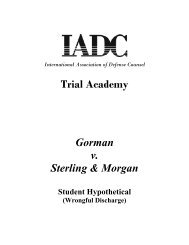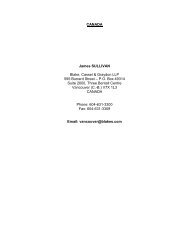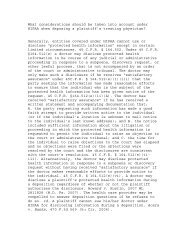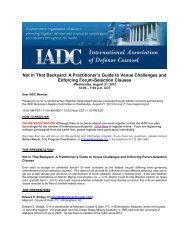Defense Counsel Journal - International Association of Defense ...
Defense Counsel Journal - International Association of Defense ...
Defense Counsel Journal - International Association of Defense ...
Create successful ePaper yourself
Turn your PDF publications into a flip-book with our unique Google optimized e-Paper software.
Newsletters Page 499brand-name counterparts and that it wasimpossible to simultaneously complywith both federal law and any state tortlawduty that required them to use adifferent label.” 5In an opinion delivered by JusticeThomas, the Supreme Court held that“federal drug regulations applicable togeneric pharmaceutical manufacturersdirectly conflict with, and thus preempt,”state law failure to warn claims. 6Pre-emption occurs where “it is‘impossible for a private party tocomply with both state and federalrequirements.’” 7 As discussed below,there remains uncertainty as to thebreadth <strong>of</strong> the holding in Mensing,namely whether it is limited to failure towarn claims or if it causes state lawdesign defect product liability claims tobe pre-empted as well.The pre-emption question inMensing was framed as applying togeneric pharmaceutical manufacturersonly, because regulations governinglabeling for brand-name and genericmanufacturers differ. 8 “A brand-namemanufacturer seeking new drugapproval is responsible for the accuracyand adequacy <strong>of</strong> its label. ”9 “A5 Id.6 Id. at 2572.7 Mensing, 131 S. Ct. at 2577 (quotingFreightliner Corp. v. Myrick, 514 U.S. 230,287, 115 S. Ct. 1483, 131 L. Ed. 2d 385(1995)).8 Id. at 2574 (citations omitted); see also id.at 2581 (explaining how the state tort failureto warn claim in Wyeth v. Levine, 555 U.S.555, 559-560, 129 S. Ct. 1187, 173 L. Ed.2d 41 (2009), differed because a brand-namepharmaceutical manufacturer could complywith both federal and state law).9 Id. at 2574 (citations omitted).manufacturer seeking generic drugapproval, on the other hand, isresponsible for ensuring that its warninglabel is the same as the brand name’s.” 10Thus, federal regulations preventgeneric pharmaceutical manufacturers“from independently changing theirgeneric drugs’ safety labels.” 11The conflict in Mensing arosebecause, despite the federal regulations,the state tort law at issue (which hascorollaries throughout the country)“place[d] a duty directly on all drugmanufactures to adequately and safelylabel their products.” 12 As a result, itwas impossible for the genericpharmaceutical manufacturer defendantto comply with both federal and statelaw:If the [generic pharmaceuticalm]anufacturers had independentlychanged their labels to satisfy theirstate law duty, they would haveviolated federal law. . . . [S]tate lawimposed on the [genericpharmaceutical m]anufacturers aduty to attach a safer label to theirgeneric [pharmaceutical at issue].Federal law, however, demandedthat generic drug labels be the sameat all times as the correspondingbrand-name drug labels. See, e.g.,21 C.F.R. § 314.510(b)(10). Thus,it was impossible for the genericpharmaceutical manufacturers tocomply with both their state-lawduty to change the label and their10 Id. at 2574 (citations omitted).11 Id. at 2577.12 Id. at 2577.












